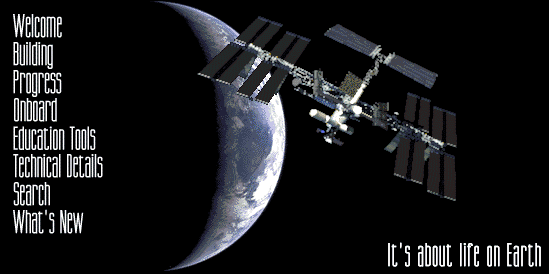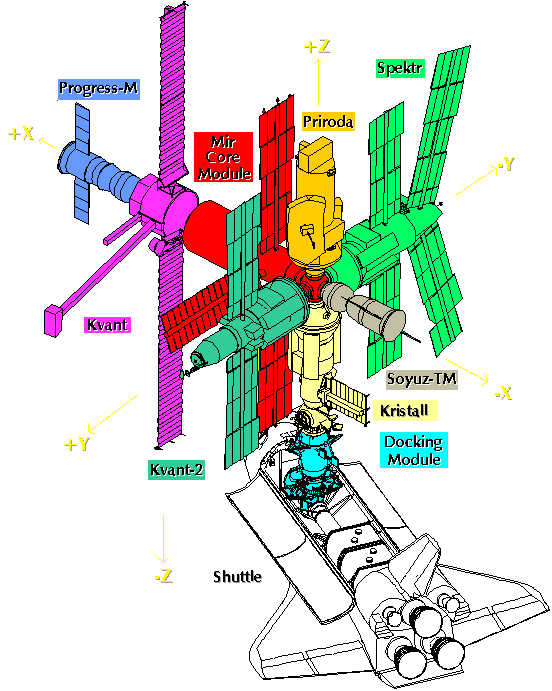



Initially, the group set out to design our own independent orbiting facility. Our decision resulted from a variety of assumptions we had made in regards to our own module(s). We saw little advantage in attaching to an existing station for the main reason that we assumed that almost anything that a station had to offer us would already need to be built into our module(s), so there was little sense in connecting. We would need our own life support, solar panels for power, and our own living quarters for the crew. We would also have to pay a "rent" of some sort to the owning country of the station, if they would even give us permission to attach in the first place. The only real advantages we saw were the docking port, which we could easily make for our own station, and the station being a mooring, which we did not see as being very important at the time. However, after some research and assistance from Glenn Chapman, we soon decided that we had been completely mistaken. If we were to attach to an existing station, then we could use a large variety of the station's different facilities, and in the end most likely get away with building only one module, which would save us a lot of money.
There are several facilities that a hosted station could share some of these include
We would also have access to the communications equipment and relay satellites, which would allow us to communicate with Earth. We would also have certain advantages with respect to the health of the crew because they would be able to interact with the other people on the station. Mooring also turned out to be a great advantage. Because of the some inherent wind resistance, space stations are constantly slowing down and falling out of orbit. This means that they must periodically boost themselves back up into orbit to prevent themselves from falling back to Earth. If we were to build our own independent facility, we would have to include a boosting system to do this. However, if we are attached to an existing station, then we would simply be pulled with the rest of the station when it boosts up. This would save money and the concern of having to boost the module. So, after discovering all of these things, it took little consideration to decide that the only intelligent thing to do was to connect with an existing space station. This prompted the question:
There are two stations that are possible hosts for the manufacturing facility:



The above image is the latest advertisement for the new and upcoming International Space Station. The original plan is to begin launching the initial pieces in 52 weeks, however this figure is doubted by many experts. .
The International Space Station (ISS) is a project which is under construction. It is a joint project of many different countries, each contributing funds and proposed modules. The countries involved include the United States, Russia, the European Community, Canada, and Japan. While this station would be an excellent choice because of the modern construction and technology, it has the disadvantage of not existing at the moment. Although it is scheduled to be completed with the next 5-6 years, which is approximately how long it should take us to get our facility ready to start, this project has been delayed before, and therefore is not a very trustworthy facility to depend upon. Countries have also begun to withdraw some of the funding towards this project, which will delay it even further. All of these things make the ISS an inappropriate choice for the a connection with our facility.

The station which is left is the Russian station, the Mir. The Mir has been around for quite a while, with the launch of the Mir core module being on Feb. 20, 1986. It now orbits at 380.4 km above the surface of the Earth at approximately 7 km/s with a period of revolution of 92.16 min. The Mir was the first space station designed to be modular, that is, the Mir was designed in such a way that additional modules could be added to it after it had been launched. This was accomplished by using multiple docking adapters, which each contain 6 docking ports, one in each direction. This would allow for easy connection of our module.The station has been recently outfitted with a docking port for the space shuttle as well.The Mir now contains 9 modules, two of which, the Progress M and the Soyuz TM (see picture of Mir), are supply craft and are periodically replaced with new versions. Just recently before this was written, for example, the Progress M-32 was undocked from the Mir and the Progress M-33 was docked.
The only problem which may occur from attaching to the Mir is that the Russian economy has not exactly been in good shape recently, so it possible that funding may be withdrawn from maintaining the facility. The station has also been in orbit for over a decade, and as all things do, it has to wear out eventually. These things suggest that we should make our module such that it will attach to the Mir now, but make it general enough that we can move to the ISS in the future, should it become necessary.



